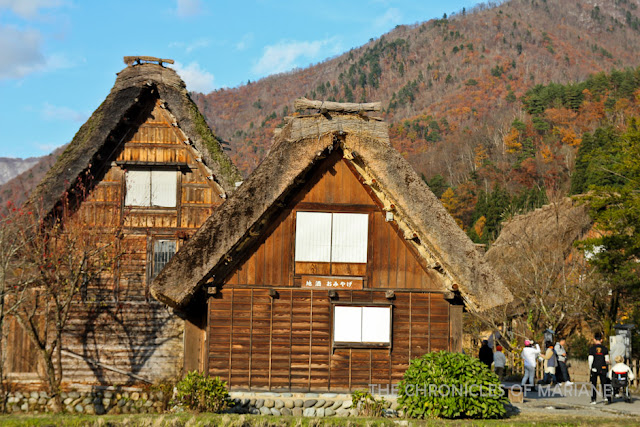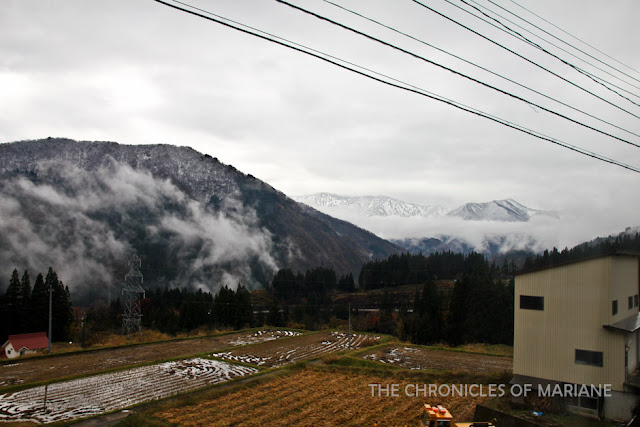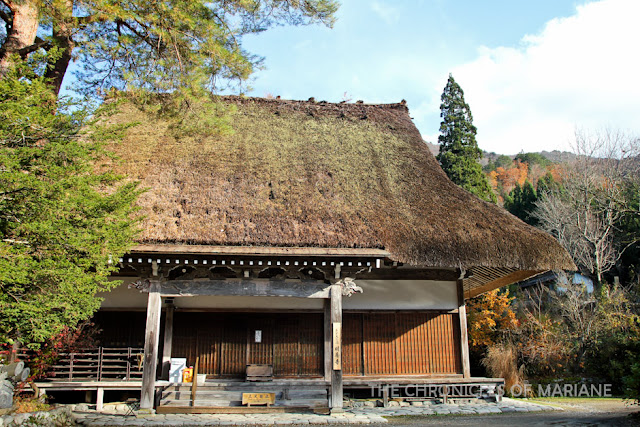Regarded as one of the country’s UNESCO World Heritage Sites, the picturesque mountainous sites situated along the Sho River called Shirakawago of Gifu Prefecture and Gokayama of Toyama Prefecture are not only known for its heavy snowfall but also for its one-of-a-kind and beautifully preserved thatched-roof houses. In these remote areas, the gassho-zukuri style, which roughly translates to “prayer hands” is utilized during construction. This makes use of steeply slanted thatched roofs that serves as protection from the heavy snowfalls during winter while providing a sturdy home for the locals living in the area.
The three historic villages of Ogimachi, Ainokura and Suganuma can be found in a secluded river valley surrounded by the high mountains of Central Japan. Due to its isolation, the area was able to develop and preserve its distinctive culture and practices. Moreover, having to fix and renew these thatched roofs is no easy feat, it is usually done every 20 to 30 years and is done with the whole cooperation of the entire community. Impressive!
GOING TO SHIRAKAWAGO AND GOKAYAMA ON A BUDGET
There are several options to access these charming villages of Central Japan, it ultimately depends on the traveler’s preference and schedule.
If coming from Tokyo, there is Hokuriku Shinkansen that stops at Toyama Station serving as a base point for buses going to the Shirakawago. Similarly, there is the more convenient Shin-Takaoka Station with buses plying the Gokayama-Shirakawago route. On the other hand, direct buses are also available from the cities of Takayama and Kanazawa.
At first glance, that might be confusing to people who are not familiar with the geographical orientation of these sites so for easier understanding, let’s break it down per village:
To Shirakawago:
The small town of Ogimachi serves as the region’s central hub. There’s the more convenient Nohi bus departing from Takayama Bus Terminal or Kanazawa station (with infrequent trips from Toyama Station), which is convenient for daytrippers coming from either of these cities. One way fare ranges about 2,000 JPY.
To Gokayama:
Kaetsuno Bus will be your best friend in this case, as their buses stops at both Ainokura-guchi as well as Suganuma and ends their trips at Shirakawago. It also stops by some relevant sites around the village such as Kaminashi and Hosojima.
Getting some discount transport pass would be a smart choice. There are lots of useful recommendations that may vary upon your mileage and availability. In my case, I bought the Takayama-Hokuriku Pass priced at 14,000 JPY usable for five days. It enabled me to take unlimited bus trips around the villages and also take JR train rides to Kanazawa, Takayama, Shin-Takaoka, Toyama until Kyoto (with coverage going as far as Kansai Airport in Osaka and Nagoya). I was not able to utilize the direct bus rides from Kanazawa/Takayama to Shirakawago as it required an early reservation, so please take note of it should you wish to utilize it.
More useful information over at these sites:
Takayama-Hokuriku Area Tourist Pass
Kaetsuno Bus Timetable
Nohi Bus Timetable
Going around the villages would be no difficult task as they are quite small and can be easily explored on foot! So get those feet ready for some exploring!
THE SIGHTS
OGIMACHI
The well-regarded village of Ogimachi of Shirakawa-go District is the largest of the three UNESCO world heritage site of the region. The village serves home to a huge number of thatched-roof farmhouses. It is the more touristy due to its size and accessibility.
Some of notable attractions around the village:
Gassho-zukuri Minkaen – open-air museum of 25 farmhouses that have been relocated to the village
Shiroyama Viewpoint – requires around 10-20 minute-walk from the bus stop. Can also be accessed by shuttle bus
House of Wada-ke, Kanda-ke and Nagase-ke - well-preserved gassho-style houses that have been converted as museums for public viewing
Myozenji Temple – a unique temple with its thatched-roof design
Shirakawa-go no Yu – a minshuku and an onsen (hot-spring)
AINOKURA
My first destination was the secluded Ainokura of Gokayama District that boasts of 20 gassho-sytyle farmhouses that are said to be more than hundreds of years old. Due to its location, it is the less touristy of the three villages and so minshuku or family-run lodgings is recommended to travelers for a quieter ambiance. Moreover, the village was able to keep some of its traditional culture such as its folk dances accompanied by a percussion instrument called sasara.
Some remarkable places around the village:
Ainokura Viewpoint
Murakami-ke House – farmhouse turned museum
Ainokura Folk Museums 1& 2 – former farmhouses that displays daily life in the village as well as some information about washi paper-making
Washi Workshop Hall – observe the process of producing washi papers or even try making it yourself
SUGANUMA
With only nine gassho-zukuri farmhouses in its vicinity, Suganuma of Gokayama District is the smallest World Heritage Site of the region. Similar to Ainokura, this is less visited so you can enjoy a leisure walk of its well-preserved houses, which have been converted to restaurants, museums and inns, at peace. Aside from the bird’s eye-view of this traditional village, I also adored seeing the wonderful autumn colors around Sho River.
Other sites of interests include:
Iwase-ke House - regarded as one of the largest farmhouses in Gokayama
Saltpeter Museum – want to know some secrets about gunpowder production that took place here?
Folk Museum
Want to make the most of your trip?
1) Visit during wintertime!
The main purpose of the steep roof designs of these houses is to protect the structure from the bulky snow that accumulates in this area every winter, and it is said that Ogimachi gets covered in one to even two meters of it. It turns into the loveliest winter paradise!
To take advantage of this wonderful scenery, the village holds an annual illumination event called the Shirakawa-go Winter Light-Up which happens in January to February in selected Sunday and Monday evenings. The farmhouses are lit up for two hours from 5.30pm. Due to its fame, they have now decided to limit visitors to manage the traffic in the area and advance reservations are now required. These can be arranged by joining a bus tour or staying the night in the village.
I know I wouldn’t have missed this if my trip was scheduled on a winter!
 |
| the unique manhole of Shirakawago (left), and another unique souvenir you can buy at Chuubu - sarubobo undies :P (right) |
2) Stay at a gassho-zukuri house
This one I had to purposely miss due to budget restrictions, but if I wasn’t traveling alone, I would have grabbed the opportunity to stay overnight at one of the gassho-style houses that have been converted as a B&B. It’s one of the best ways to experience Japanese hospitality as well as observe the traditional way of living in this region. Guests should not expect the usual amenities commonly seen in modern hotels, because they would only have futons for sleeping. A night stay ranges for about 8000 to 10000 JPY and are available in any of the three villages. It is recommended to reserve prior to your travel date due to its popularity.
SAMPLE ONE-DAY ITINERARY A LA AMAZING RACE STYLE
I didn’t have enough time to look for information about transportation prior to this trip so I relied on this very useful guide from Kanazawa Tourism. I wasn’t able to follow it to the dot, but I was able to take in the lovely scenery each village has to offer at a moderate pace. The file includes lots of tips, maps and some useful information about the area so give it a read :)
I started at the isolated Ainokura but if I were to do it the other way around (from Shirakawago). I could have taken the bus from Kanazawa Station through Nohi Bus that leaves at 08:10 AM and arrives at the village at 9:25 AM.
07: 23 AM: Departure from Kanazawa Station – JR Shinkansen Hakutaka
07: 36 AM: Arrival at Shin-Takaoka Station, Breakfast and grocery for snacks
08: 25 AM: Departure from Shin-Takaoka Eki – Kaetsuno Bus
09: 28 AM: Arrival at Ainokura-guchi
10: 48 AM: Departure from Ainokura – Kaetsuno Bus
11:03 AM: Arrival at Suganuma
12: 33 PM: Departure from Suganuma – Kaetsuno Bus
1:10 PM: Arrival at Ogimachi/Shirakawago
4:00 PM: Departure from Shirakawago
5: 55 PM: Arrival at Shin-Takaoka Station
6: 29 PM: Departure at Shin-Takaoka Station – JR Shinkansen Tsurugi
6: 43 PM: Arrival at Kanazawa Station
I should have reserved the previous day to catch the direct bus from Shirakawago to Kanazawa 5:30 PM through Nohi Bus (which arrives 6:45 PM at the station) for more time at the village :( Similarly there is also the direct bus to/from Shirakawa to Takayama using Nohi buses.
Would I change anything about this trip if I can redo this experience? I guess not. My goal for the entire trip to Japan was take awesome pictures, enjoy all the places and still stick to my budget. I think I achieved all three, though I would prefer to be more laidback and really take my time and stay at least one night at either one of these three villages. I do enjoy this kind of trip sometimes, truth be told. Despite all the restrictions, I loved the feeling of being in an “Amazing Race” completing the challenge of making it on the bus on time, researching the best route and also talking to locals to figure out how to get from one place to the next. However, if money was not a big issue, you would definitely not read about an exhausting itinerary, but a relaxed one instead. Looking forward to having a chance to visit these UNESCO sites during winter or spring soon!























No comments :
Post a Comment